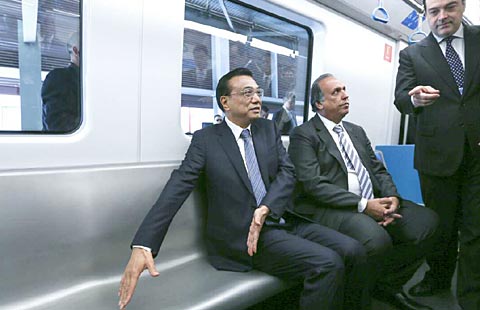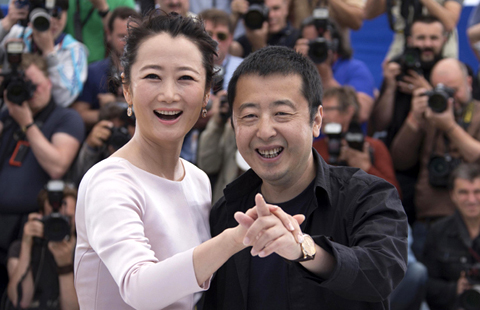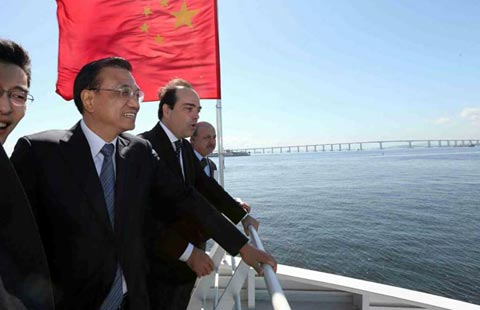New Silk Road a boon for enterprises
Updated: 2015-05-15 11:17
By Shi Jing in Shanghai(China Daily USA)
|
||||||||
China's latest Belt and Road Initiative will provide more opportunities for State-owned enterprises and privately-owned companies in overseas markets as it expands infrastructure links from the mainland to Europe via Southeast Asia and Africa.
Due to their ample funding, large SOEs will be able to embark on large infrastructure projects which incur longer investments and lower profit margins, said Gabriel Wong, head of corporate finance at PwC Shanghai.
In contrast, privately-owned enterprises mostly focused on investments with shorter term returns and will fully leverage their existing resources. Some of them will make good use of their advanced technologies and competitive advantages to penetrate specific sectors, which may provide better shorter term return, he said.
"As countries included in the initiative have different development statuses, their needs will vary," Wong said.
"Countries like Indonesia may have a huge demand for infrastructure projects, whereas others will require consumer products like air-conditioners, refrigerators, cheaper cell phones, and so forth."
China's equipment manufacturing industry has struggled with overcapacity and a supply glut of raw materials since the global financial crisis of 2008, reflecting how its development has been bottlenecked.
This makes the Belt and Road Initiative a more crucial regenerator of these industries because it can help transfer excessive capacity. A lot of the countries involved offer cheap premises, raw materials and labor.
"Many have limited fiscal budgets, so even basic sectors like transportation, healthcare and education are underdeveloped," said Wong.
"This obviously makes it harder for them to develop their high-end industries. Chinese companies must be careful to do their research before rushing in."
One area that stands to benefit is China's textile industry, which has faced problems of oversupply in the affluent cities lining China's east coast for a long time, according to Jenny Chong, head of Asia Pacific international tax services at PwC.
The industry will find many opportunities to transfer inventory to countries like Bangladesh, she added.

One State-owned textile company in Shanghai has already helped to build an industrial park in the densely populated country of over 250 million people.
"Bangladesh has a quite well-developed textile industry. It accounted for large part of the country's GDP last year. But the lack of a high-end industrial park has hampered further growth," she said.
"In projects like these, SOEs can be the key driver in building the industrial park as the investment size is very large. However, Chinese private companies such as textile manufacturers can move their production plant into the industrial park once built to take advantage of the lower labor and material cost of the local market," she added.
"This is a good example of the different roles that SOEs and privately-owned companies will play in practice vis--vis the new initiative."
Also referred to as the Silk Road Economic Belt and 21st Century Maritime Silk Road, the plan was proposed by Xi in 2013. The idea is to rejuvenate the two ancient trading routes and further tap markets along the way in a mutually beneficial manner.
The "belt" part of the plan was announced during Xi's visit to Kazakhstan in September 2013. It includes countries located on the original Silk Road through Central Asia to Europe, extending to some parts of South Asia. It envisions a cohesive economic area with increased cultural exchanges and broadened trade.
The 21st Century Maritime Silk Road is aimed at investing and fostering collaboration in Southeast Asia, Oceania and North Africa. Xi first raised it during a speech to Indonesia's parliament in October of that year.
To support the projects, the China-backed Asian Infrastructure Investment Bank was set up last year with the participation of 56 other countries.
Last November, Xi announced plans to create a $40-billion development fund, partly to give the initiative strong financial backing.
shijing@chinadaily.com.cn

 Culture Insider: Six things you may not know about Grain Buds
Culture Insider: Six things you may not know about Grain Buds
 Premier Li rides on new China-made train in Rio de Janeiro
Premier Li rides on new China-made train in Rio de Janeiro
 NYC's new One World Observatory offers sweeping views of Manhattan
NYC's new One World Observatory offers sweeping views of Manhattan
 Disney flagship store opens in Shanghai
Disney flagship store opens in Shanghai
 Sinkhole glimpse of magical nature
Sinkhole glimpse of magical nature
 Top 10 hottest destinations for investment in 2015
Top 10 hottest destinations for investment in 2015
 Jia Zhangke's movie screened at Cannes
Jia Zhangke's movie screened at Cannes
 Premier Li meets entrepreneurs on China-made ferry in Rio de Janeiro
Premier Li meets entrepreneurs on China-made ferry in Rio de Janeiro
Most Viewed
Editor's Picks

|

|

|

|

|

|
Today's Top News
Li: 'Great potential' for Sino-Colombian ties
Beijing sets out its rights after reports of incursion
China may have edge in race to build California's bullet train
US Senate votes to move forward fast-track trade legislation
Colombia runs into infrastructure bumps on road to prosperity
Premier Li arrives in Bogota to start official visit to Colombia
China is a global leader in renewable energy: Panel
Chinese premier arrives in Colombia for official visit
US Weekly

|

|







